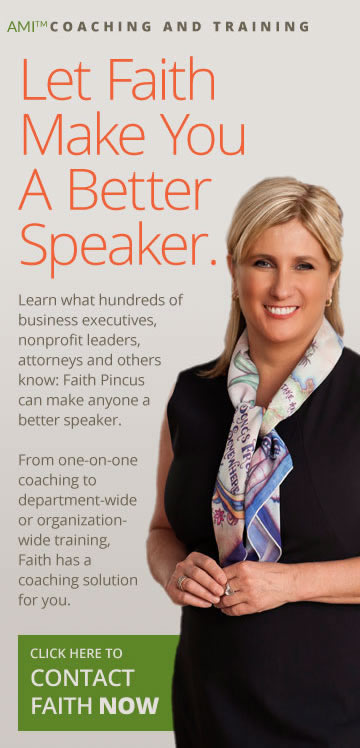Focus on eye contact
Making eye contact with your audience throughout your entire presentation is the number one way you can improve your delivery style as well as to enhance your presence and the impression people have of you.
Eye contact is the primary way to reach, and connect with, your audience. Eye contact makes you appear confident, credible, in control. A speaker who studiously reads from their prepared remarks and rarely looks up or regards their audience can be seen as either shifty, boring or both. The simple rule is: talk directly to people and they will listen to you.
The eyes have it
So how do you do it? To begin with, let’s start with the size of your audience. If it is small (less than 50 people or so) you will find many opportunities to make eye contact with virtually every member of your audience. As you speak, vary your eye contact with different parts of the room. In other words, make sure you don’t focus on one side only, which I’ve seen speakers do time and again.
Additionally, try to avoid focusing on that one person in the audience to whom you will naturally gravitate. That’s usually the one person that gives you positive non-verbal feedback. I call them “friendly faces.”
While you do want to make eye contact with friendly faces throughout your presentation (better than looking at the guy reading the paper), you don’t want to focus on just one person. Why? Because over time, you will begin to make that person feel really uncomfortable. Nobody likes being the center of attention for too long if they’re not asking for it. What’s more, the rest of the audience will be saying, “What about us? We have needs too.” The remainder of the audience will eventually tune you out as you will appear to be having your own private conversation with that one person.
If you have a larger audience, it will be impossible for you to make eye contact with everyone, but that’s not a problem. The solution is to divide the audience into sections. Mentally split the group into four or six or whatever different quadrants. Within each quadrant, seek out the one or two people who are “friendly faces.” Once you do, everyone else near that person will think that you’re looking at them. It has to do with depth perception.
Dividing your audience for effect
The best way to explain it is via analogy: Have you ever been walking down the street and somebody waves to you or starts speaking and you don’t know who they are? Then right when you’re going to respond (or sometimes after), you discover they’re actually targeting the person behind you? That’s what I’m talking about here. If you look at those one or two people within that quadrant, everyone else in their vicinity will think you’re making eye contact with them.
Once you’ve established your mental quadrants and found the friendly faces to address, you’ll want to vary it up throughout the room. This should be done randomly, not systematically. (You don’t want to look like a robot: “Now I look left. Now I look right. Now I look left again.”) Make a personal connection with your audience. Use eye contact to engage in a dialogue or a conversation with as many of them as you can.
As you proceed, you should attempt to adjust your presentation depending on the feedback that you’re getting. If you’re getting the “I am lost” look, go back and re-explain. If you’re getting, the “Oh my gosh! I’m bored off in la-la land” look from your audience, you need to take the time toto re-engage your listeners.
Don’t let eye contact become a distraction
A final word about eye contact: It can sometimes be distracting to the speaker. You look up, you find a friendly face and then…you realize they look like your first grade teacher. Or your ex-husband. Or your mailman. And in that moment, that brief second of distraction, you brain can be jolted and your train of thought can de-rail. Prepare for this. Practice maintaining your composure and staying on track until you can know that even if you were to look up and see Santa Claus staring back at you, you could keep going without batting an eye.
Eye contact is, and will remain, the single best way to engage an audience. I repeat it here because it cannot be overstated.
 Did you enjoy this article?
Did you enjoy this article?



